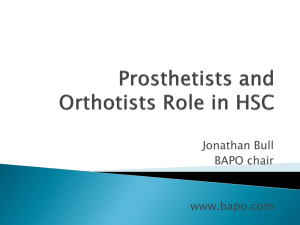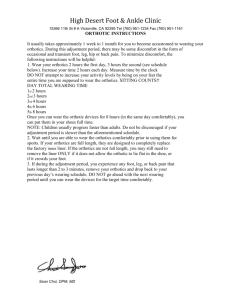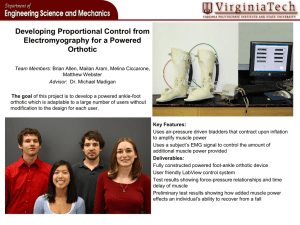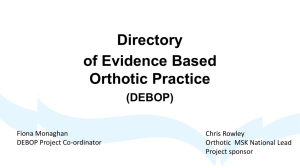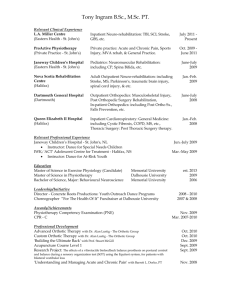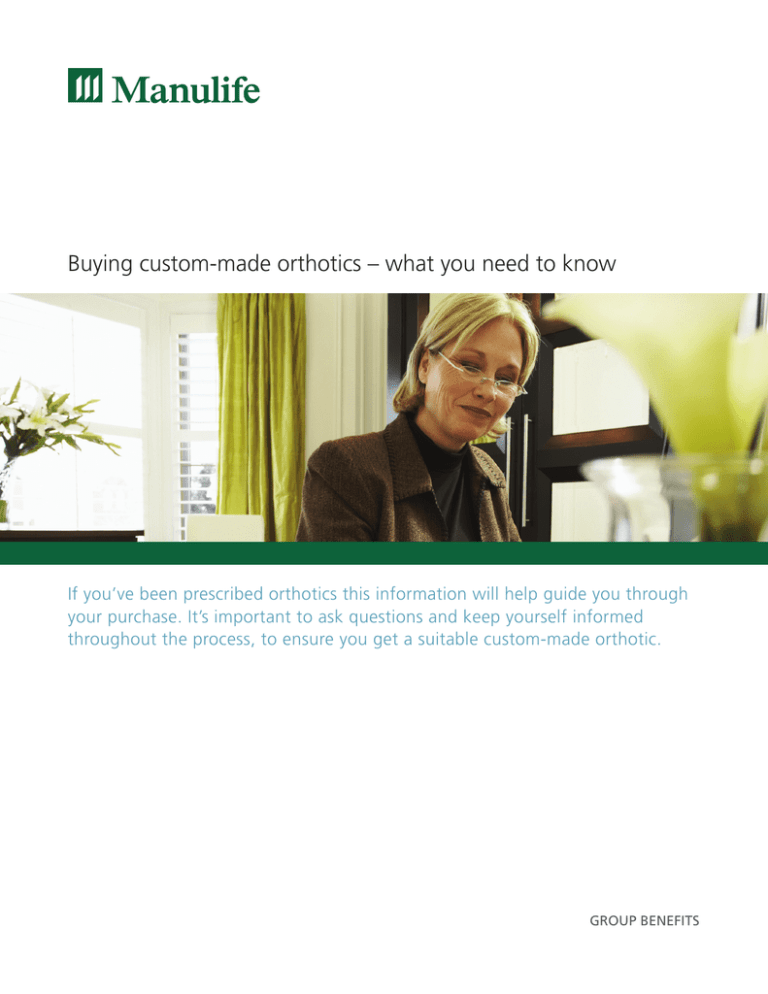
Buying custom-made orthotics – what you need to know
If you’ve been prescribed orthotics this information will help guide you through
your purchase. It’s important to ask questions and keep yourself informed
throughout the process, to ensure you get a suitable custom-made orthotic.
GROUP BENEFITS
Who’s authorized?
Custom-made orthotics are prescribed by specific
healthcare professionals, which include physicians,
podiatrists and chiropodists. They will diagnose whether
or not an orthotic would be beneficial to your situation.
Many suppliers offer orthotics. For all Canadian
provinces, except Quebec, podiatrists, chiropodists,
pedorthists are recognized as foot care specialists.
For the province of Quebec a foot orthotist or an
orthotist prosthetist working in a laboratory accredited
by the Québec Ministry of Health and Social Services
and who is a member of the Order of Professional
Technologists of Quebec and a podiatrist are the eligible
providers of orthotics.
The prescribers and providers listed above are licensed
and governed by either a provincial or national body,
and are subject to standards of practice. This, along
with each body’s Code of Ethics, helps ensure their
accountability and your protection.
What to expect for your assessment
After being prescribed an orthotic, you’ll need to visit
one of the providers listed above for an assessment.
A provider will guide you through an extensive
evaluation to ensure an orthotic is the best option
and that it’s properly designed. You should expect the
orthotic provider to perform the following:
Medical History Review: a complete investigation
and documentation of your medical history, symptoms
and previous injuries. He or she will also take into
consideration your lifestyle (occupation and activities) as
well as your current and past footwear (fit, style, wear
and pattern).
Examination: a hands-on evaluation of the lower limbs
including foot structure, alignment, strength, range
of motion, soft-tissue damage as well as identifying
any abnormalities.
Gait Analysis: The provider will observe you walking
to identify accommodations or abnormalities. For
instance whether you favour one leg or the other.
Orthotic Evaluation: The provider will determine
treatment options and explain how the treatments
will address your specific needs.
Casting: Taking a mould ensures that your orthotic
is made with all of the contours and structure of
your foot. A proper cast is essential to create a truly
custommade orthotic. Casting techniques include:
foam box casting, plaster of paris slipper casting,
contact digitizing and laser scanning.
■■
Having your footprint taken on an inkpad or using
your shoe size to provide a prefabricated insole
is not considered casting and does not qualify as
custom-made.
Manufacturing: For an orthotic to be claimed
under your benefit plan, it must be constructed from
scratch and fabricated directly from your mould. You
can expect at least one-week between your initial
assessment and your fitting appointments.
Some providers will supply what’s called a “best fit”
footbed. These are prefabricated inserts that are
matched to your cast, however the cast is never used
in the actual manufacturing of the orthotic. These
are not considered custom-made and would not
qualify under your benefit plan.
Orthotics that aren’t manufactured specifically to
your needs can result in pain by overstressing your
muscles, bones and joints.
Dispensing: Custom-made orthotics should be
fitted specifically for you and your footwear. The
provider should evaluate how you walk while
wearing the orthotics. You should also be offered a
follow up appointment within 2-6 weeks of receiving
your orthotic.
Education: The provider should educate you on
things like breaking in your new orthotics, lifespan,
as well as how they should fit. You should also be
made aware of any warning signs that the orthotics
are not working properly and instructed to return if
you experience any problems.
Be cautious – things to be aware of
when buying an orthotic
■■
■■
■■
■■
■■
■■
■■
■■
■■
■■
For all Canadian provinces except Quebec
– Physician – M.D.
– Podiatrist – D.P.M.
– Chiropodist – D.Ch. or D Pod M
– Pedorthist – C.Ped. (C). or C Ped (MC)
A provider should have the capacity to modify your
orthotic.
Exercise caution when considering the purchase of
orthotics from exhibits at trade shows, home shows
or sportsman shows. If there’s a problem with the
orthotic, returning it could be a problem, not to
mention they probably aren’t custom-made.
For the province of Quebec
– A foot orthotist or an orthotist prosthetist
working in a laboratory accredited by the Quebec
Ministry of Health and Social Services (MSSS) and
who is a member of the Order of Professional
Technologists of Quebec – T.P.
– Podiatrist - D.P.M.
Exercise caution when considering the purchase from
iosks or booths in malls, department stores or over
the internet for the same reasons.
Be wary of people who come to your home, or
conduct group screenings of employees or family
members without a proper evaluation.
“Two for the price of one” deals or “free giveaways”
with your purchase are not allowed under the code
of ethics that regulated providers and dispensers are
bound by. Some providers will use these “freebies”
to inflate the price of an orthotic.
Be suspicious of any provider that can’t answer your
questions clearly or gives vague and ambiguous
answers.
Prescribers and providers should have the following
designations in their titles.
■■
■■
■■
Check your benefits booklet to see which prescribers
your plan specifies.
If you feel pressured to purchase additional products
or are uncomfortable with the business practices of
the provider, consider another provider.
Don’t ever give the provider a signed claim form.
You are responsible for that claim submission and
the only way to be sure of what is submitted is to
complete it and mail it yourself.
Question a provider who strongly recommends you
see a doctor of his or her choosing for a referral
instead of your family physician.
Question a provider who recommends your whole
family could benefit from orthotics without having
seen or assessed them individually.
Custom-made orthotics for children under 5 are
highly uncommon. Skeletal or soft tissue injuries
that require orthotic treatment don’t usually present
themselves until a person is older. If for some reason
they do need an orthotic, a medical doctor or
pediatric specialist must prescribe it.
Please note that some of the examples listed above may not pertain to your
benefit plan. Consult your benefit plan for details.
Group Benefits products are offered through Manulife (The Manufacturers Life Insurance Company). © The Manufacturers Life Insurance Company. All rights reserved. Manulife and the block
design are service marks and trademarks of The Manufacturers Life Insurance Company and are used by it and its affiliates under license.
GC2231E 04/2016


